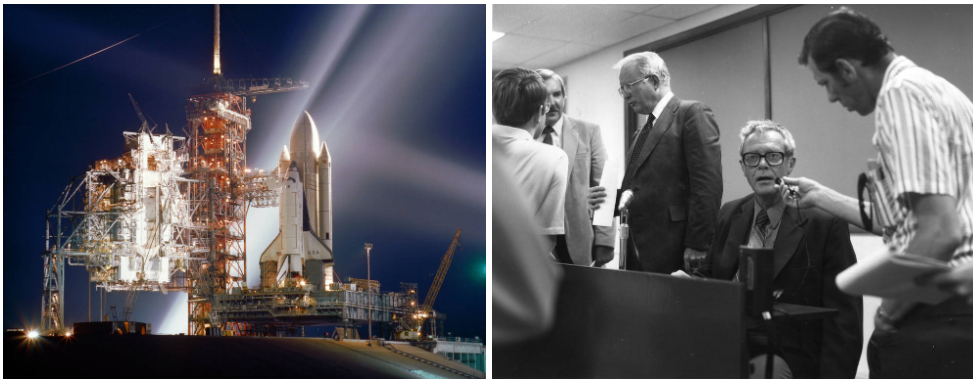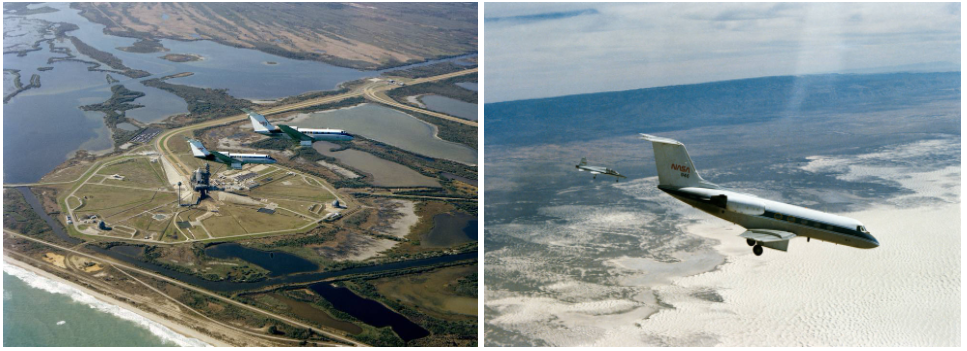40 Years Ago: The Launch of STS-1 Just Two Weeks Away
With the first launch of the Space Transportation System (STS), better known as the space shuttle, fast approaching, workers at NASA’s Kennedy Space Center in Florida continued to prepare Columbia for its historic mission. Engineers completed tests to verify the integrity of the external tank’s foam insulation. Managers from NASA Headquarters and several field centers met at Kennedy to hold a final review to assess the readiness of the vehicle, ground systems, and crew training for the upcoming mission and set April 10, 1981, as the target launch date. The STS-1 crew of Commander John W. Young and Pilot Robert L. Crippen participated in a press conference to review their mission and answer reporters’ questions. Mission managers assessed concerns with the runway at the primary landing site following recent unseasonably heavy rains.

Left: Space Shuttle Columbia on Launch Pad 39A at NASA’s Kennedy Space Center in Florida, where ground crews successfully completed two tanking tests to verify the external tank’s foam insulation. Right: Acting NASA Administrator Alan M. Lovelace, standing at left, and John F. Yardley, NASA associate administrator for Space Transportation Systems, answer reporters’ questions after the conclusion of the Flight Readiness Review that cleared Columbia for launch. Credits: NASA
Engineers successfully completed two tanking tests on March 25 and 27 to verify repairs to the external tank’s foam insulation, damaged during a tanking test in January. Workers spent two weeks earlier in March repairing three areas of debonded foam. During the two tanking tests, technicians loaded super cold liquid hydrogen and liquid oxygen into the external tank to determine if flexing from the sudden temperature change caused any foam debonding. Post-test inspections revealed no issues, clearing the tank for the first launch. Senior managers from NASA Headquarters, Kennedy, Johnson Space Center in Houston, and Marshall Space Flight Center in Huntsville, Alabama, met at Kennedy on March 31 to review the readiness of all aspects of the mission, including the flight vehicle, ground support systems, mission operations support, and crew training. At the conclusion of the Flight Readiness Review, managers targeted shortly after dawn on April 10, 1981, as the launch time for STS-1, with the initial countdown beginning late on April 5.
John F. Yardley, NASA associate administrator for Space Transportation Systems, commented to reporters after the review, “Frankly, I’ve never seen a vehicle that’s so clean before its first flight.”
 Left: STS-1 astronauts Robert L. Crippen, left, and John W. Young during the final preflight crew press conference in the main auditorium of NASA’s Johnson Space Center in Houston. Middle: Crippen answers a reporter’s question. Right: Young explains an aspect of their mission to a reporter. Credits: NASA
Left: STS-1 astronauts Robert L. Crippen, left, and John W. Young during the final preflight crew press conference in the main auditorium of NASA’s Johnson Space Center in Houston. Middle: Crippen answers a reporter’s question. Right: Young explains an aspect of their mission to a reporter. Credits: NASA
Young and Crippen met with reporters on March 9, providing a brief overview of their 54-hour, 36-orbit mission — the first time that astronauts would be aboard a crewed spacecraft’s very first flight. The first of four orbital test flights, STS-1 planned to address 130 of the 170 overall objectives of the operational test flight program, including verification of all major spacecraft systems. The astronauts addressed reporters’ concerns about the shuttle’s thermal protection system, or tiles, given the difficulties encountered during the spacecraft’s preflight preparations. Neither Young nor Crippen foresaw any major issues occurring with the tiles during the mission. They also addressed the various contingencies that could occur during the mission and the training they’d received to deal with them. As Crippen said, because of the delays, he and Young “have the dubious honor of being the crew that’s trained the longest for any single flight.”

Left: STS-2 backup astronauts Joe H. Engle and Richard H. Truly pilot two Gulfstream Shuttle Training Aircraft (STA) in formation above Columbia on Launch Pad 39A at NASA’s Kennedy Space Center in Florida. Right: STS-1 astronauts John W. Young and Robert L. Crippen pilot the STA, practicing landing at Northrup Strip, now the White Sands Space Harbor, in New Mexico. Note the steep angle of attack and the landing gear lowered to increase drag to better simulate the shuttle’s flying characteristics. Credits: NASA
At the end of the mission, Young and Crippen planned to bring Columbia in for a landing at the Dryden Flight Research Center, now NASA’s Armstrong Flight Research Center, at Edwards Air Force Base in California. For the first landing of the reusable spacecraft, mission managers believed the 5.2-mile long Runway 23 on Rogers Dry Lake provided the greatest margin of safety. The lakebed runway, normally dry and offering a solid surface for the shuttle to land on, had turned soggy due to unseasonably heavy rains earlier in March. The wet conditions caused concerns about whether the runway could dry in time to support an April landing. For that reason, mission managers began to consider making Northrup Strip, now the White Sands Space Harbor in New Mexico, as the prime target for STS-1’s landing. Young and Crippen had already practiced landing at Northrup Strip as a designated alternate landing site, as well as at Dryden and Kennedy’s Shuttle Landing Facility, flying the Shuttle Training Aircraft, a Gulfstream II highly modified to simulate the flying characteristics of the space shuttle. By the time of launch, Young and Crippen will have flown about 1,330 landing approaches in the Shuttle Training Aircraft.
To be continued …
STS-1 Anniversary Events to Watch
Join the NASA Alumni League at 2:30 p.m. on April 1 via Zoom to celebrate the 40th anniversary of STS-1 with Bob Crippen, Dick Truly, Gene Kranz, Neil Hutchinson, Chuck Lewis, and Stokes McMillan.
Employees can join the panel using the Zoom browser extension or by accessing the panel via a personal device.
The center will also air a Johnson/Kennedy panel with current crew discussing how the lessons from STS-1 are carrying forward as NASA launches a new generation of vehicles. This panel will air on the 40th anniversary date, Monday, April 12, at noon. Stay tuned for more details.







